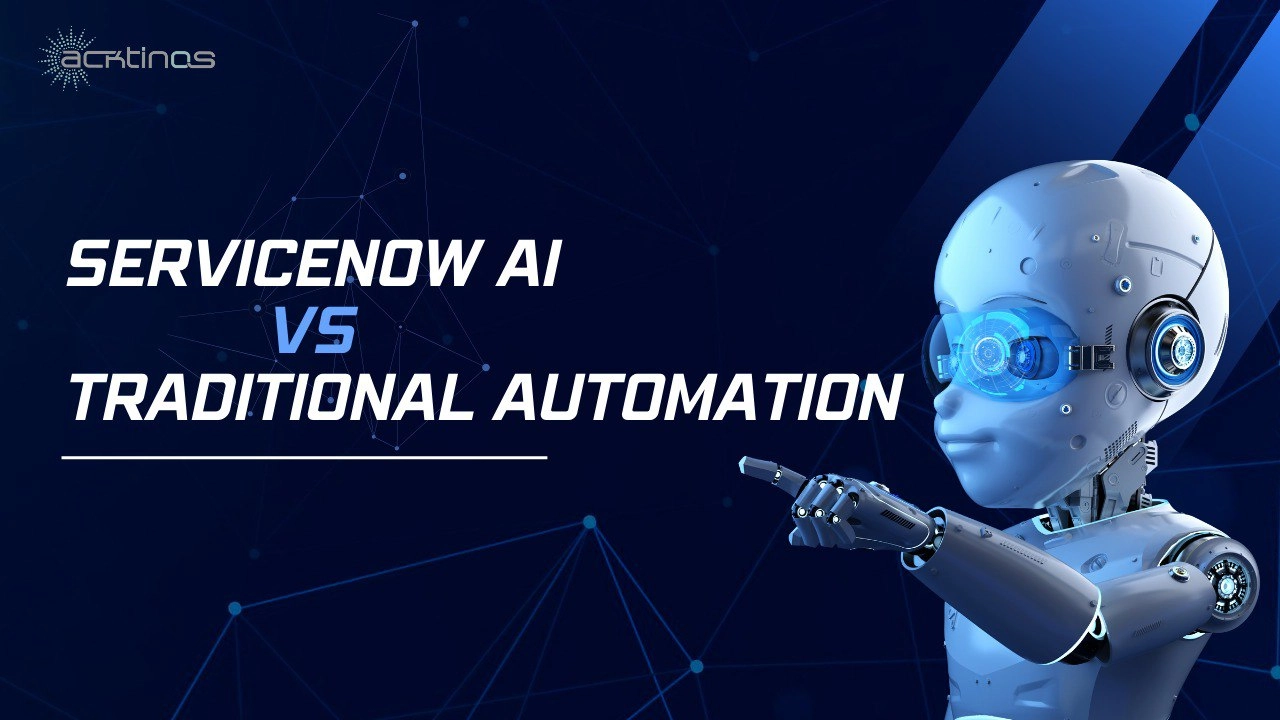As enterprises accelerate their digital transformation, choosing the right automation tools becomes critical for maximizing efficiency and ROI. ServiceNow AI is reshaping how organizations approach IT service management (ITSM) and operations, but how does it compare with traditional automation solutions? More importantly, what difference does this make for your bottom line?
This blog explores the ROI benefits of ServiceNow automation powered by AI and compares it to conventional automation approaches, offering insights to help you optimize workflows and boost operational efficiency.
Understanding Traditional Automation
Traditional automation typically involves scripted, rule-based workflows designed to execute repetitive tasks. Examples include automatic ticket routing, password resets, or data entry automation.
- Strengths: Predictable, reliable, reduces manual effort on repetitive tasks
- Limitations: Rigid, unable to adapt to exceptions or learn from data, limited scalability
While these systems reduce labor costs, their static nature can limit ROI when faced with complex or evolving IT environments.
What Is ServiceNow AI and Intelligent Automation?
ServiceNow AI integrates machine learning, natural language processing, and predictive analytics into its platform to enable intelligent automation and AI-powered workflows. This means:
- Tasks are automated with context-aware decision-making.
- Systems learn from historical data to improve over time.
- End-users benefit from conversational AI and proactive incident detection.
This shift from static to dynamic, adaptive automation enhances workflow efficiency and reduces manual interventions.
ROI of ServiceNow vs. Traditional Automation
The ROI difference largely comes down to:
- Process Optimization with AI: ServiceNow AI continuously refines workflows, reducing bottlenecks and preventing issues before they occur, saving time and money.
- Improved Incident Response: AI-powered ITSM detects patterns and automates resolution steps faster than traditional scripted workflows.
- Scalability and Flexibility: ServiceNow AI can handle complex, multi-departmental processes across IT, HR, and customer service.
- User Experience and Adoption: Conversational AI improves self-service rates, lowering support costs.
Studies show organizations adopting ServiceNow AI see significant reductions in operational costs, increased productivity, and faster time-to-resolution compared to traditional automation users.
AI in ITSM and IT Operations Automation
Integrating AI into ITSM platforms like ServiceNow transforms IT operations by:
- Predicting and preventing outages through anomaly detection
- Automating routine maintenance with intelligent scheduling
- Enhancing knowledge management with AI-curated content
- Providing AI-driven insights for better decision-making
This results in a more proactive IT approach and less downtime.
Digital Transformation and Enterprise AI Adoption
ServiceNow AI is a critical tool in broader digital transformation initiatives:
- Accelerates enterprise AI adoption by embedding intelligence into familiar workflows
- Reduces dependency on manual processes and legacy systems
- Aligns IT and business goals through process automation and analytics
The platform’s flexibility supports organizations of all sizes in their journey to becoming data-driven and customer-centric.
Key Considerations for Evaluating Automation ROI
Before deciding between ServiceNow AI and traditional automation, consider:
- Current IT complexity and integration needs
- Volume and type of tasks suitable for AI-driven automation
- Long-term scalability and maintenance costs
- Employee training and change management capabilities
Choosing the right automation solution impacts not just immediate ROI but long-term business agility.
Enhancing Workflow Efficiency with AI-Powered Insights
One of the standout advantages of ServiceNow AI is its ability to deliver actionable insights that traditional automation cannot match. By analyzing vast amounts of data in real time, AI identifies inefficiencies and suggests optimizations within workflows.
- Root cause analysis: AI can pinpoint underlying problems causing frequent incidents.
- Predictive analytics: Helps forecast future issues, enabling proactive measures.
- Resource allocation: AI recommends optimal distribution of personnel and assets based on workload and priorities.
This continuous feedback loop ensures workflows become more efficient over time, directly boosting ROI.
Reducing Operational Risk through Intelligent Automation
Intelligent automation within ServiceNow doesn’t just improve speed—it also reduces errors and operational risk, a key factor in ROI calculations.
- AI reduces the chance of human error in repetitive or complex processes.
- Automated compliance checks help ensure policies and regulations are consistently followed.
- Incident response automation decreases the likelihood of costly outages or security breaches.
By minimizing risks, organizations avoid expensive downtime and penalties, preserving resources and reputation.
Real-World Examples of ROI with ServiceNow AI
Many organizations have reported impressive ROI gains after adopting ServiceNow AI:
- A large financial institution reduced incident resolution time by 40%, resulting in millions saved annually in operational costs.
- A global retailer automated 60% of their IT requests, significantly reducing help desk workload and improving employee satisfaction.
- A healthcare provider used AI to proactively identify system vulnerabilities, preventing costly downtime and enhancing patient care.
These success stories highlight how intelligent automation drives tangible business value beyond cost-cutting.
Conclusion
While traditional automation provides foundational efficiency gains, ServiceNow AI offers a smarter, more adaptive approach that drives higher ROI through intelligent automation, enhanced workflow efficiency, and better alignment with digital transformation goals.


